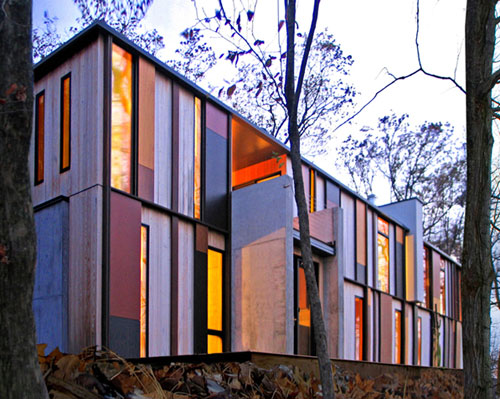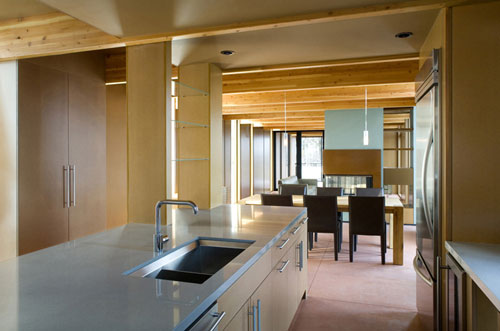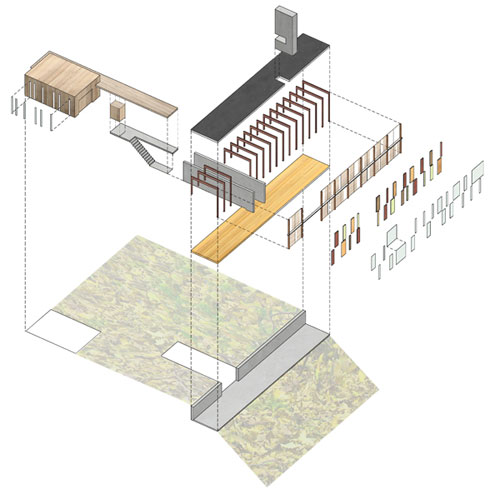By Ingrid Spencer-via:archrecord

When we wrote about Milwaukee-based Johnsen Schmaling in February 2005, the then-two-year-old firm was just getting its feet wet with both residential and commercial projects that showed promise and innovation. Now, two years later, one house in particular, called the Camouflage House, has truly put the team on the map. The owner of the home, John Geiger, who grew up around architects because his father was a blueprinter in Milwaukee, says he chose Johnsen Schmaling because he knew they would give him a unique second home—one he would eventually want to occupy full-time. Still, the level of attention the house has achieved takes him aback. “It’s a real testament to how creative Brian and Sebastian and the builders were with this house,” he says. For firm principals Brian Johnsen, AIA, and Johnsen Schmaling Architects, the attention is surprising, but not unwelcome. “It’s been nice,” says Schmaling, modestly.

Modesty is part of what this house is all about, given that at 2,700 square feet, and with a simple palette of common materials, it is neither large nor extravagant. “I wanted honest materials and enough room for me, my wife, and our two sons,” says Geiger. “Then I gave them a pretty free hand to do what they do.”
 What Johnsen and Schmaling did was create a narrow, linear volume nestled into a hillside above Wisconsin’s Green Lake. The home’s profile virtually disappears into the wooded site—thus the name. “You enter on the second level, where all the home’s public functions take place,” says Schmaling. “The ground level, where the bedrooms are, is submerged.” The seemingly random pattern of building skin of solids and voids—constructed of wall and glass panels—overlaps with the strict 48-inch base grid of the building’s exposed structural columns. Clad in untreated vertical cedar and a series of different colored Prodema wood veneer panels, the cladding echoes the changing hues of the surrounding trees across the seasons. Schmaling points out that the cedar will weather to a silver-gray while the veneer panels will retain their finish.
What Johnsen and Schmaling did was create a narrow, linear volume nestled into a hillside above Wisconsin’s Green Lake. The home’s profile virtually disappears into the wooded site—thus the name. “You enter on the second level, where all the home’s public functions take place,” says Schmaling. “The ground level, where the bedrooms are, is submerged.” The seemingly random pattern of building skin of solids and voids—constructed of wall and glass panels—overlaps with the strict 48-inch base grid of the building’s exposed structural columns. Clad in untreated vertical cedar and a series of different colored Prodema wood veneer panels, the cladding echoes the changing hues of the surrounding trees across the seasons. Schmaling points out that the cedar will weather to a silver-gray while the veneer panels will retain their finish.
The house is organized with kitchen, dining, and living areas all on the upper level. You enter this level from a linear, glazed entry foyer across from a breezeway connecting house and garage that penetrates the rectangular building and terminates in a partially covered balcony with spectacular views of the lake. By retracting large folding glass doors, the open living area extends into a spacious screened porch. Stairs connect to the lower level, which is fully exposed on the lakeside and houses the three 9-foot-by-9-foot square bedrooms. A zero-edge bluff terrace stretches along the length of the lower level to the master bedroom “grotto,” an outdoor area between the western edge of the house and an imposing rock formation on the site.
 The interior reflects the architects’ contemporary take on Wisconsin’s historic lake-cottage architecture, which traditionally featured exposed timber construction, wood cladding, combined living and dining areas centered around a large fireplace, and natural materials. In that vein, the entire upper level is clad with clear-sealed MDF panels by reveals that align with exposed engineered, structural wood beams above. Concrete floors throughout and a three-sided Cor-ten steel-clad fireplace add to the house’s raw, sculptural quality. Low-VOC paints, recycled products, native woods, and high-performance glazing were all specified to add sustainable qualities.
The interior reflects the architects’ contemporary take on Wisconsin’s historic lake-cottage architecture, which traditionally featured exposed timber construction, wood cladding, combined living and dining areas centered around a large fireplace, and natural materials. In that vein, the entire upper level is clad with clear-sealed MDF panels by reveals that align with exposed engineered, structural wood beams above. Concrete floors throughout and a three-sided Cor-ten steel-clad fireplace add to the house’s raw, sculptural quality. Low-VOC paints, recycled products, native woods, and high-performance glazing were all specified to add sustainable qualities.
The house has scored several awards, including an Honor Award from the Wisconsin AIA. But, says Geiger, his two teenage sons still haven’t shown due respect. “As a child, I was the little kid on the bus picking up plans from these huge architects,” he says. “And now, sitting in a room with them as part of an awards ceremony where my own house is being honored, I’m in total awe.” I’ve grown up thinking that architecture is the highest form of art and that architects, Sebastian and Brian included, just see things differently than other people,” says Geiger. While he knows that his kids love the house, he says that to them it’s still just “Dad’s folly.” But he believes that the Camouflage House is the kind of place that will just keep getting better over the years. “We’ll be getting a boat, and installing a tram system to get it down to the lake,” he says. “I know for the kids, appreciation will come in time.”

Axon
